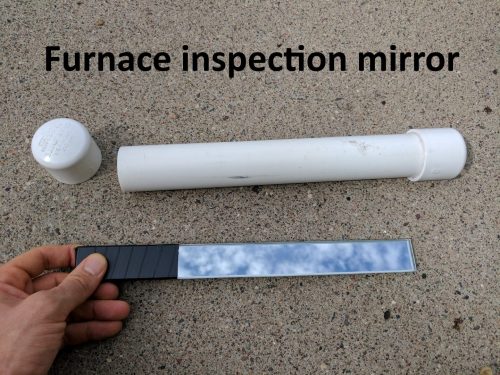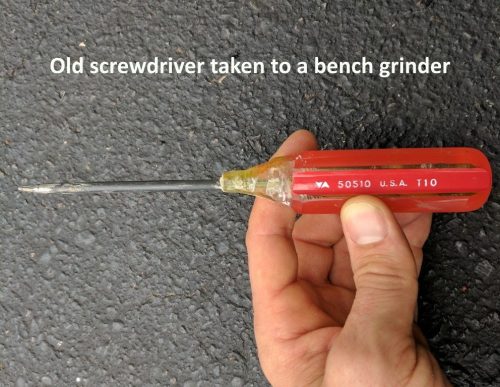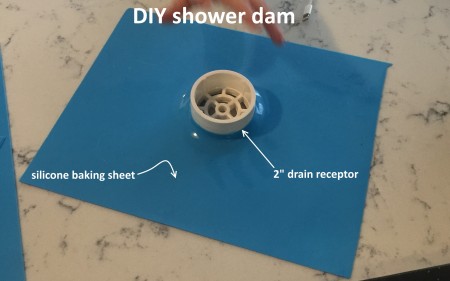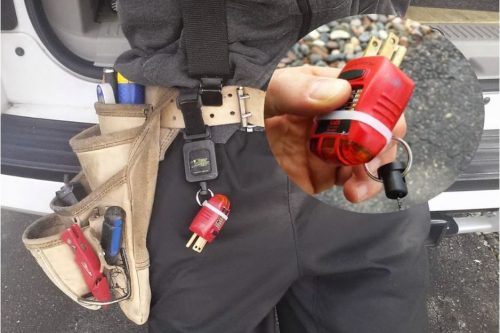I’ve put together a tool list for my inspectors. I’ve shared this tool list on home inspection discussion forums so many times that I decided I should put it on my website in the form of a blog post. This is definitely not a must-have tool list for all home inspectors, but it is for the inspectors in my company.
Specialized, expensive home inspection equipment
• Combustible Gas Detector – I prefer the TIF8900. See A comparison of three gas sniffers.
• Infrared Camera – See FLIR E6: the best infrared camera for home inspectors.
• Pin-probe moisture meter – See Protimeter Surveymaster: The best moisture meter for home inspectors.
• Non-contact moisture meter – See above. The Surveymaster does both.
• Combustion Analyzer that also measures CO – My preference is the Testo 310. It’s extremely durable and the battery lasts forever.
Generic equipment
• 28’ Extension Ladder
• Adjustable ladder – I’ve always used a 17’ Little Giant, but some of my inspectors prefer the Xtend+Climb ladder.
• Super-powerful flashlight, backup flashlight – see This home inspector’s update on flashlights. I’ve been using the Fenix TK35 since 2011 and it’s still my favorite.
• Digital camera – see Camera buying advice for home inspectors.
• Cordless drill/driver – see Milwaukee M12 FUEL™ 1/4″ Hex Impact Driver.
• ¼” drill bit – for CO testing.
• Inspection mirror – something like this.
 • Furnace inspection mirror – this is a long, skinny piece of mirror with ground edges. I have a glass shop make them for my inspectors. The mirrors are 1-1/4″ wide x 12″ long. I use this mirror to inspect heat exchangers on old furnaces, sub-slab ductwork, the undersides of composite siding… lots of stuff. It’s a great tool that I use even more than my inspection mirror. I keep it inside of a short length of PVC. See the photo at right.
• Furnace inspection mirror – this is a long, skinny piece of mirror with ground edges. I have a glass shop make them for my inspectors. The mirrors are 1-1/4″ wide x 12″ long. I use this mirror to inspect heat exchangers on old furnaces, sub-slab ductwork, the undersides of composite siding… lots of stuff. It’s a great tool that I use even more than my inspection mirror. I keep it inside of a short length of PVC. See the photo at right.
• Tape measure – my current favorite is the Milwaukee magnetic tape measure.
• Screwdriver with numerous bits – two great options are the MegaPro or the Milwaukee 10-in-1.
• 4’ Level
• Torpedo level – for convenience.
• Tool Bag – Get a rolling tool bag. All of this equipment is heavy.
• Wearable tool pouch(es)
•  Awl/ice pick/probing tool – an old screwdriver taken to a bench grinder works well. I tend to lose mine, but replacements are always free.
Awl/ice pick/probing tool – an old screwdriver taken to a bench grinder works well. I tend to lose mine, but replacements are always free.
• Utility knife
• Putty knife
• Longnose pliers
• Half-mask respirator – every attic, no exceptions. The 3M 07193 mask is good, but the ‘Bane’ mask is much smaller, and better suited for home inspections: GVS SPR457
• Socket set – because you never know.
• Thermometer – preferably the meat probe style. I like the DeltaTRAK jumbo display.
• Aluminum tape, UL listed – for covering a test hole in a gas appliance vent, and other miscellaneous stuff.
• Blue painters tape – clients can use this to mark cosmetic items during new-construction inspections.
• Yellow electrical tape – for marking the exact locations of gas leaks.
• Black permanent marker – for marking the yellow tape.
• Butane lighter with a long wand – for lighting pilots.
• Drop cloths or painters poly (.35 mil) – to place below attic access panels. Never, ever, ever leave a mess.
Clothing
• Indoor shoes
• Work gloves
• Clean gloves – for lifting white attic access panels. Never leave fingerprints.
• Rubber overshoes or rain boots – a must for muddy new-construction job sites.
• Rain gear – including a spare umbrella for clients.
• Cold weather gear – get Baffin boots. Your feet will thank you.
• Crawlspace gear – coveralls or grubby clothes to change into.
Electrical
• Non-contact voltage tester – Get the Fluke 2AC almost a year ago. It’s always on, I’m still on my first set of batteries, and it won’t get set off by low-voltage stuff that I don’t care about. Also, this only detects voltage at 90 volts and above, which is what we’re concerned with. Other voltage testers will be more prone to false positives.
• Two-lead voltage tester – I recommend the GET-3100.
• Three-prong outlet tester – the Amprobe ST-102B feels good in your hand.
• Clamp electrical meter – for testing hot circuits identified with an infrared camera. See Using an infrared camera to find an overloaded circuit. This device should also double also a multimeter for those times when you’re really curious about something.
Plumbing
•  Water pressure gauge – infrequently used, but necessary to determine excess pressure when suspected.
Water pressure gauge – infrequently used, but necessary to determine excess pressure when suspected.
• Gas leak detection solution – this is the only acceptable method for reporting a gas leak.
• Shower dam – for testing tiled showers. We make our own shower dams. See the photo at right.
• Water hardness test strips – for testing water softeners. We use the Hach Total Hardness Test Strips.
• Flexseal – for repairing any and all plumbing leaks identified during the home inspection. Just kidding. This one isn’t on our real list.
Optional, recommended equipment
• Backup camera – a mobile phone camera will work in a pinch, but they don’t have the same zoom or flash capability.
• Headlamp – highly recommended for attic inspections. I bought a cheap $12 headlamp on a whim over three years ago, and the dang thing won’t quit on me. It’s bright as all get-out and uses the same 18650 batteries as all of my flashlights. It’s the best $12 I’ve ever spent. It’s no longer available on Amazon, but I found another one that looks to be way better for about $18: 6000 lumen CREE headlamp
• Extra three-prong outlet tester
• Bolt Cutters – padlocked electrical panel? Padlocked crawlspace? Call the seller’s agent and get permission to gain access. If permission is granted, complete the inspection.
• Various pliers/wrenches – you never know.
• Open-end pliers, various sizes – again, you never know.
• Hammer – a wise home inspector once told me that whatever I’m planning to do with a hammer during a home inspection is probably a bad idea. He was probably right. Still, I keep one in my truck. I would have made a great Boy Scout.
• Mini pry-bar – like the Vaughan 222CS. For whatever. It’s super handy.
• Large flat bar
• Vinyl siding zip-tool – to easily take a peek behind vinyl siding.
• Pipe wrench
• Safety glasses
• Hard hat – sometimes required by builders for new construction and pre-drywall inspections.
• Flat rubber drain stopper – for testing tubs and sinks.
• Vacuum – I’m tempted to move this to the ‘required’ category. Almost everyone in my company uses the Milwaukee M12 cordless vacuum. This is such a great little tool that I bought a second one just to keep in my basement.
• Microwave tester – a cup of water works just fine to confirm that a microwave is capable of warming stuff up, but a microwave tester looks cooler.
• Charging battery – in case your infrared camera battery is dead, or your Testo battery, or similar equipment.
• GearKeeper tether – never lose your three-prong outlet tester again, never have to dig for it again. Always have it readily accessible, even when wearing big winter gloves. See the photo below.
• Glass suction cup – for crank-out windows that won’t close properly. See Glass Suction Cup. Added 5/15/18
As I mentioned at the beginning, this is a dynamic tool list that will continue to change, and it isn’t for everyone. I plan to keep this tool list updated as I find newer and better tools. Did I miss any? Do you have any better suggestions? If so, please leave a comment. Thanks for reading!


Jason Hamrick
May 16, 2017, 8:52 pm
Great read, even the flexseal part. Thank you for taking the time to out this together.
Tristan Eager
May 18, 2017, 11:06 am
I love 18650 batteries, but they do require extra care. Buy a reputable brand from a reputable seller. Use a high quality charger. Get a carrying case for your spares. PD35 is my primary light. It’s a little bit bluer than I like, but overall it is great.
Great post, thanks!
jeff
May 24, 2017, 10:24 am
One of your best posts, for a tool geek, loved reading it, thanks Reuben, for a nit, spelling would be peek in line ( Vinyl siding zip-tool – to easily take a peak )
Reuben Saltzman
May 24, 2017, 12:07 pm
Gah! Fixed, thank you.
Kevin
June 6, 2017, 2:46 pm
For gloves, I prefer to use the Level 5 cut-resistant, puncture-resistant gloves. For moving around in crawlspaces and attics, they give good protection from an unseen chard of glass or sharp stone, or an unseen nail going into the hand. And you can still pick things up easily with them. They’re also made with touchscreen ability.